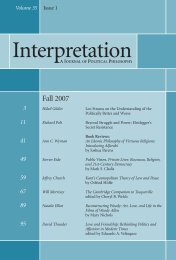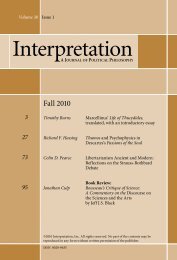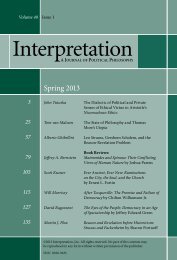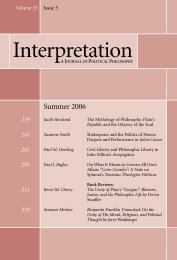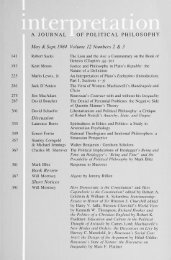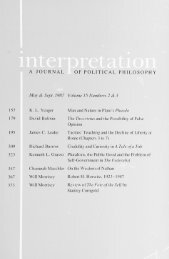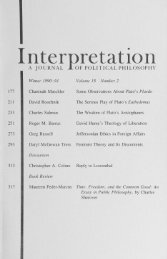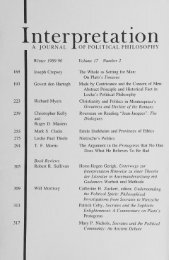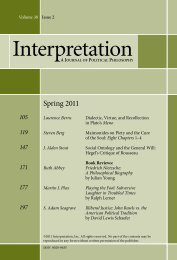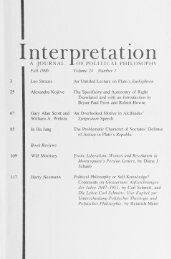Spring 2010 - Interpretation
Spring 2010 - Interpretation
Spring 2010 - Interpretation
Create successful ePaper yourself
Turn your PDF publications into a flip-book with our unique Google optimized e-Paper software.
Creation as Parable in Maimonides’ Guide of the Perplexed<br />
2 7 1<br />
peshat whose relation to the truth is as silver filigree to golden apple, they<br />
heaped layer upon layer of non-porous coatings on the few grains of core they<br />
extracted. Their goal was clearly to keep people so engrossed in the layers of<br />
rind that they would not suspect that there lay beneath them a few grains, and<br />
certainly not that these few grains trace their own origins back to a solid core.<br />
As Maimonides says in 3.43, with respect to the midrashim: “Those who<br />
understand their [the Sages’] discourses” see these midrashim as “political<br />
conceits; they are not meant to bring out the meaning of the text in question”<br />
(572-73). There are some among those who imagine that the Sages indeed<br />
intend to explain the meaning of the text in question who therefore accord<br />
to the midrashim “the same status as traditional legal decisions.” There are<br />
others who, recognizing that what the midrashim say “is not the meaning<br />
of the text in question,” simply ridicule the midrashim. In truth, however, a<br />
midrash “is a most witty poetical conceit” by means of which the Sages seek<br />
to instill “a noble moral quality,” supporting it “through reference to a biblical<br />
text, as is done in poetical compositions” (573).<br />
The Guide’s Introduction contains a similar analysis of the<br />
various approaches to midrash: “an ignoramus…would find nothing difficult<br />
in them, inasmuch as a rash fool, devoid of any knowledge of the nature of<br />
being, does not find impossibilities hard to accept. If, however, a perfect man<br />
of virtue should engage in speculation on them, he cannot escape one of two<br />
courses: either he can take the speeches in question in their external sense<br />
and, in so doing, think ill of their author and regard him as an ignoramus—<br />
in this there is nothing that would upset the foundations of belief; or he can<br />
attribute to them an inner meaning, thereby extricating himself from his<br />
predicament and enabling himself to think well of the author whether or not<br />
the inner meaning is clear to him” (10). Note that here, too, as in the case of<br />
the parables of the Law, in order to think well of the midrashim it is sufficient<br />
to recognize that they have an inner meaning; one need not know what the<br />
internal meaning is.<br />
Let us turn now to 2.25, where Maimonides defends his professed<br />
belief that the world was created (see also 1.71, 2.6, 2.13, 3.10). (The<br />
question of whether Maimonides sincerely believed the world was created<br />
or secretly harbored an Aristotelian belief in the world’s eternity has generated<br />
voluminous discussion. Among the pivotal scholarly contributions to<br />
this question are Klein-Braslavy 1968; W. Harvey 1981; Dunphy 1989; Ivry<br />
1982; Wolfson 1973; Ravitsky 1966; Nuriel 1964; Hyman 1987; Glücker 1959;<br />
and Loberbaum 2002.) That there has been no definitive demonstration of



